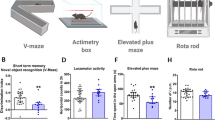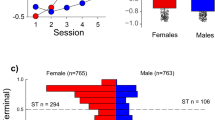Abstract
There is increasing evidence that genetic factors can influence individual differences in vulnerability to drugs of abuse1,2. Serotonin (5-hydroxytryptamine, 5-HT), acting through many receptors can modulate the activity of neural reward pathways and thus the effects of various drugs of abuse3,4,5,6,7,8. Here we examine the effects of cocaine in mice lacking one of the serotonin-receptor subtypes, the 5-HT1B receptor9. We show that mice lacking 5-HT1B display increased locomotor responses to cocaine and that they are more motivated to self-administer cocaine. We propose that even drug-naive 5-HT1B-knockout mice are in a behavioural and biochemical state that resembles that of wild-type mice sensitized to cocaine by repeated exposure to the drug. This altered state might be responsible for their increased vulnerability to cocaine.
This is a preview of subscription content, access via your institution
Access options
Subscribe to this journal
Receive 51 print issues and online access
$199.00 per year
only $3.90 per issue
Buy this article
- Purchase on Springer Link
- Instant access to full article PDF
Prices may be subject to local taxes which are calculated during checkout




Similar content being viewed by others
References
Crabbe, J. C., Belknap, J. K. & Buck, K. J. Genetic animal models of alcohol and drug abuse. Science 264, 1715–1723 (1994).
Koob, G. F. Drugs of abuse: anatomy, pharmacology and function of reward pathways. Trends Pharmacol. Sci. 13, 177–184 (1992).
Parsons, L. H., Weiss, F. & Koob, G. F. Serotonin1b receptor stimulation enhances dopamine-mediated reinforcement. Psychopharmacology 128, 150–160 (1996).
Peltier, R. & Schenk, S. Effects of serotonergic manipulations on cocaine self-administration in rats. Psychopharmacology 110, 390–394 (1993).
Carroll, M. E., Lac, S. T., Asencio, M. & Kragh, R. Fluoxetine reduces intravenous cocaine self-administration in rats. Pharmacol. Biochem. Behav. 35, 237–244 (1990).
Parsons, L. H. & Justice, J. B. J Perfusate serotonin increase extracellular dopamine in the nucleus accumbens as measured by in vivo microdialysis. Brain Res. 606, 195–199 (1993).
Cameron, D. L. & Williams, J. T. Cocaine inhibits GABA release in the VTA through endogenous 5-HT. J. Neurosci. 14, 6763–6767 (1994).
Callahan, P. M. & Cunningham, K. A. Modulation of the discriminative stimulus properties of cocaine by 5-HT1B and 5-HT2C receptors. J. Pharmacol. Exp. Therap. 274, 1414–1424 (1995).
Saudou, F.et al. Enhanced aggressive behavior in mice lacking 5-HT1B receptor. Science 265, 1875–1878 (1994).
Wise, R. & Bozarth, M. Apsychomotor theory of addiction. Psychol. Rev. 94, 469–492 (1987).
Lucas, J. J., Segu, L. & Hen, R. 5-Hydroxytryptamine1B receptors modulate the effect of cocaine on c-fos expression: converging evidence using 5-hydroxytryptamine1B knockout mice and the 5-hydroxytryptamine1B/1D antagonist GR127935. Mol. Pharmacol. 51, 755–763 (1997).
Graybiel, A. M., Moratalla, R. & Robertson, H. A. Amphetamine and cocaine induce drug-specific activation of the c-fos gene in striosome-matrix compartments and limbic subdivisions of the striatum. Proc. Natl Acad. Sci. USA 87, 6912–6916 (1990).
Young, S. T., Porrino, L. J. & Iadarola, M. J. Cocaine induces striatal c-fos-immunoreactive proteins via dopaminergic D1 receptors. Proc. Natl Acad. Sci. USA 88, 1291–1295 (1991).
Hope, B. T.et al. Induction of a long-lasting AP-1 complex composed of altered Fos-like proteins in brain by chronic cocaine and other chronic treatments. Neuron 13, 1235–1244 (1994).
Nestler, E. J., Hope, B. T. & Widnell, K. L. Drug addiction: a model for the molecular basis of neural plasticity. Neuron 11, 995–1006 (1993).
Chen J., Kelz, M. B., Hope, B. T., Nakabeppu, Y. & Nestler, E. J. Chronic Fos-related antigens: stable variants of deltaFosB induced in brain by chronic treatments. J. Neurosci. 17, 4933–4941 (1997).
Hiroi, N.et al. FosB mutant mice: loss of chronic cocaine induction of Fos-related proteins and heightened sensitivity to cocaine's psychomotor and rewarding effects. Proc. Natl Acad. Sci. USA 94, 10397–10402 (1997).
Mandelzys, A., Gruda, M. A., Bravo, R. & Morgan, J. I. Absence of a persistently elevated 36-kDa fos-related antigen and AP-1 like DNA binding activity in the brains of kainic acid-treated fosB null mice. J. Neurosci. 17, 5407–5415 (1997).
Browne, S. P., Moore, C. M., Scheurer, J., Tebbett, I. R. & Logan, B. K. Arapid method for the determination of cocaine in brain tissue. J. Forens. Sci. 36, 1662–1665 (1991).
Loh, E. A. & Roberts, D. C. Break-points on a progressive ratio schedule reinforced by intravenous cocaine increase following depletion of forebrain serotonin. Psychopharmacology 101, 262–266 (1990).
Boschert, U., Amara, D. A., Segu, L. & Hen, R. The mouse 5-hydroxytryptamine1B receptor is localized predominantly on axon terminals. Neuroscience 58, 167–182 (1994).
Parsons, L. H., Koob, G. F. & Weiss, F. Serotonin-1B receptor stimulation enhances cocaine reinforcement, cocaine-induced increases in nucleus accumbens dopamine, and cocaine-induced decreases in ventral tegmental area GABA.(Soc. Neurosci. 26th Annu. Meeting, Washington, DC, 1996).
Castanon, N., Lucas, J. J., Scearce, K. & Hen, R. The 5-HT1B/1D antagonist GR 127935 decreases the effects of cocaine on c-fos expression and locomotion.(Soc. Neurosci. 26th Annu. Meeting, Washington, DC, 1996).
Horger, B. A., Shelton, K. & Schenk, S. Preexposure sensitizes rats to the rewarding effects of cocaine. Pharmacol. Biochem. Behav. 37, 707–711 (1990).
Crabbe, J. C.et al. Elevated alcohol consumption in null mutant mice lacking 5-HT1B serotonin receptors. Nature Genet. 14, 98–101 (1996).
Brunner, D. & Hen, H. in The Neurobiology of Suicide: From the Bench to the Clinic (eds Stoff, D. M. & Mann, J. J.) 81–105 (N.Y. Acad. Sci., New York, 1997).
Rocha, B., Ator, R., Emmett-Oglesby, M. & Hen, R. Intravenous cocaine self-administration in mice lacking 5-HT1B receptors. Pharmacol. Biochem. Behav. 57, 407–412 (1997).
Depoortere, R. Y., Li, D. H., Lane, J. D. & Emmett-Oglesby, M. W. Parameters of self-administration of cocaine in rats under a progressive-ratio schedule. Pharmacol. Biochem. Behav. 45, 539–548 (1993).
Sonnenberg, J. L., Macgregor-Leon, P. F., Curran, T. & Morgan, J. I. Dynamic alterations occur to the levels and composition of transcription factor AP-1 complexes after seizure. Neuron 3, 359–365 (1989).
Acknowledgements
We thank E. Gardner and J. Chen for biochemical characterization of the mice, R. Aton for help with self-administration studies, and R. Yarmolinksy for help with preparation of the figures. This work was supported by grants from NIDA, Bristol-Meyers, and a HHMI predoctoral fellowship (K.S.-L.)
Author information
Authors and Affiliations
Corresponding author
Rights and permissions
About this article
Cite this article
Rocha, B., Scearce-Levie, K., Lucas, J. et al. Increased vulnerability to cocaine in mice lacking the serotonin-1B receptor. Nature 393, 175–178 (1998). https://doi.org/10.1038/30259
Received:
Accepted:
Issue Date:
DOI: https://doi.org/10.1038/30259
This article is cited by
-
A role for reward valuation in the serotonergic modulation of impulsivity
Psychopharmacology (2021)
-
Response dynamics of midbrain dopamine neurons and serotonin neurons to heroin, nicotine, cocaine, and MDMA
Cell Discovery (2018)
-
The 5-HT1B receptor - a potential target for antidepressant treatment
Psychopharmacology (2018)
-
Decreased Incentive Motivation Following Knockout or Acute Blockade of the Serotonin Transporter: Role of the 5-HT2C Receptor
Neuropsychopharmacology (2016)
-
Decreased Cocaine Motor Sensitization and Self-Administration in Mice Overexpressing Cannabinoid CB2 Receptors
Neuropsychopharmacology (2012)
Comments
By submitting a comment you agree to abide by our Terms and Community Guidelines. If you find something abusive or that does not comply with our terms or guidelines please flag it as inappropriate.



